| The Beck Diamax Microscope A brief look at one of the last stands made in the UK By Paul James (uk)
|
| The Beck Diamax Microscope A brief look at one of the last stands made in the UK By Paul James (uk)
|
The Beck 'Diamax' must rank as one of the last stands produced in the UK. It is a fairly traditional microscope having qualities blending the old with the new. At the time, angular designs crept in to microscope manufacturing but Beck's 'Diamax' is certainly anything but angular and reminds me of the tradtional forms produced during the mid 1900's. In short there is much to praise in this somewhat elegant design which was offered both in monocular and binocular forms.
The Stand
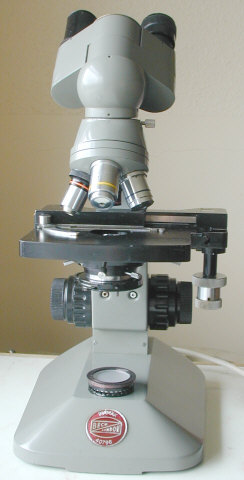 |
Note the the simplicity of form with smooth flowing lines and importantly the ample space beneath the stage where hands can easily make adjustments and allow the placement of improvised gadgetry such as shutters or flash reflex housing etc., above the field aperture of the illumination source.
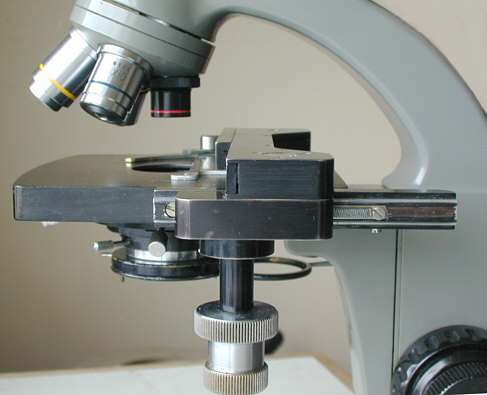 |
The stand is reassuringly rigid and substantial, weighing around 6 kilos (14 lbs) and has a plain simple base with tapered sides allowing comfortable manipulation of the concentrically housed fine and coarse focus controls. Having a positive coarse adjustment and perfectly smooth fine control makes for restful observation : a feeling akin to that which emanates from a high class microscope.
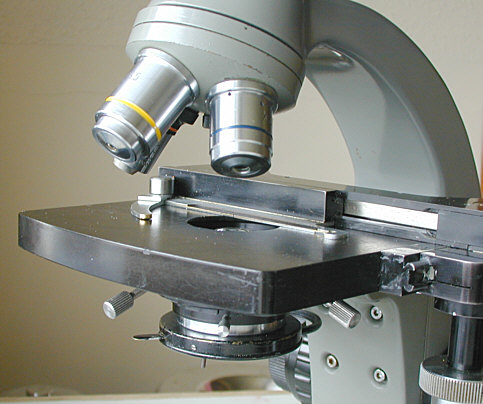 |
Stage
A fairly straight forward design here and a mechanical slide holder is provided on this model with concentric drop down controls which offer positive and smooth control over slide motion. The resistance to both the x & y axis movements can be adjusted to satisfy personal requirements, and is easily carried out using a small clock maker's screw driver. Although restricted in total coverage of a 3x1 inch slide compared with some professional stands, the Diamax's slide movement on both x & y movements should be of adequate coverage for most amateur use. Its stability when using highpower was more than adequate as I was not initially conscious of this when manipulating the drop down controls : the hall mark of good design.
Substage
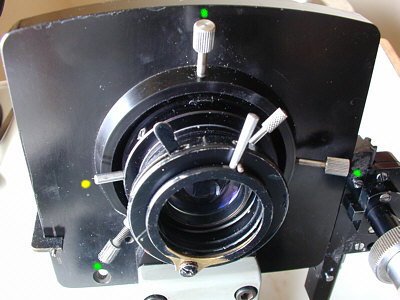 |
The substage assembly is if anything a little too compact and so getting to know where the substage controls are with enquiring fingers takes time as it does on any microscope, but a little more so here. The whole assemblage is supported from underneath the stage. Raising and lowering of the condenser through a helical pin system uses a horizontally acting lever and for smooth yet positive operation does require that the condenser centring screws are not set too firmly, otherwise distortion and partial seizing of the mechanism results. This method of condenser support and control is compact almost to a fault, and though it does not take up as much substage space as a traditional rack and pinion device would, its initial setting up takes a little time and skill to get just right. Once the condenser was nipped in its support ring and orientated to suit personal preferences to lever positioning etc., the substage operated quite well. The condenser can be centred using the 3x 120 degree screw adjusters and is a facility which should be installed on every microscope. It wasn't quite as positive and as easy to adjust as the excellent 2 screw plus spring loaded design but at least it was there. Some expensive high quality stands simply do not have provision for any substage centration, other than by accessing awkwardly placed nipping screws which are certainly not user friendly and convenient.
The 3 element aplanatic condenser is a capable quality optic, performing best with top lens removed for all objectives up to and including the x40, and fully illuminating an oil immersion objective when replaced.
Illumination
Beck had originally provided both electric and/or mirror illumination for this stand, but this particular example of the Diamax came with the optional mirror unit and a non standard electric source from a modified illumination fitment under the base casting.
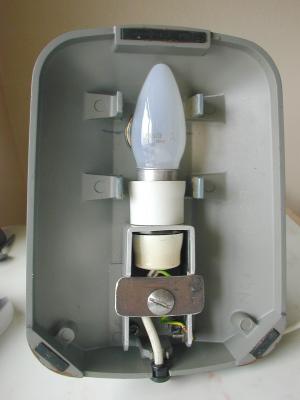 |
There is no lamp condenser as with Critical/Koehler illumination setups but there is a simple yet effective 15 watt 'candle' mains bulb which does have the merit of being very easy and cheap to replace, and for me at least of eye friendly light output. A diffuser and blue filter are housed above in the 'field' assembly both broadening and colour correcting the light output to the condenser, and its cooling is aided through the use of breather holes around the field aperture's periphery.
Such an arrangement might appear in the first instance to be lacking in critical refinements, but Koehler illumination was designed specifically for the demands of evenly lit field, high contrast photomicrography which I think this stand was not designed for. I'm not demeaning the ability of the Diamax, far from it, but I think it's more likely role is as a visual instrument for the education establishments and the amateur : novice or advanced.
I found that its 'diffused' lighting to be more than adequate for Brightfield, Oblique and Darkfield in areas of interest which the keen amateur would likely be investigating. The heat from the bulb was noticed but didn't rise above about 40°C. during long periods of use, and could be a bonus during the colder spell of winter !
Objective Turret
A four position objective turret is used which is very robust, but its internal mechanism appeared to be rather devoid of lubrication and therefore made a clunky undamped sound when rotated. However, the important facility of accurately placing each optic over the optical axis remained reassuringly positive.
Optics
Unfortunately the microscope came to me with only a couple of Beck's own objectives ( x10 & x40 ) but no eyepieces. I therefore can only make comments about the two objectives that were present on the stand, which I suspect are of imported origin, though I could be wrong. I'd class them as being of adequate optical quality and commensurate for such a stand. I have however decided to install Olympus achromatic objectives, as they are of comparable cost on the used market and chanced upon more easily than Beck's own.
As the original x40 was a phase optic, I assume that the Diamax must have been offered with a phase condenser and telescope ?
Binocular head
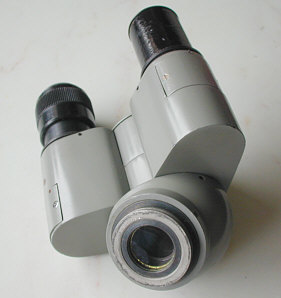 |
The optical quality of the binocular head was very good : an important part of the stand, which if wayward in any way can completely spoil the enjoyment of observing pleasure. It is a well engineered and solid assemblage having the expected facility of a one eyepiece independent focussing tube and a variable inter pupillary distance setting. It is of a design in which the eyepiece's focus, and relative focus remain the same at any interpupillary setting which simplifies setup and occasional alteration during use. It had a ring dovetail for coupling to the upper limb which was very easy to remove and install. Monocular and phototubes as well as vertical illumination tubes were supplied and can also be attached to the limb.
Accessories
Apart from the independent mirror housing which might be considered an accessory, such attachments as the photo tube, and vertical illuminator were available and extended the 'scope's usefulness.
Some Final Thoughts
I have to say I was impressed with the Diamax despite a few little quirks and the necessity of some very minor 'engineering' and adjustments of the substage assembly, and also in the illumination department.
Its Achilles heel : the substage assembly, did not have the solid permanence of settings that examples from the top manufacturers possess, but was neverthless at least capable of radial adjustment through the application of some mechanical sensitivity on behalf of the observer. Having said that the substage was adequate once things were sorted out.
Its ability to yield fully illuminated fields from and including the x4 to the x40 objective without need of any time consuming substage activity other than tweaking iris and elevation of condenser, is a welcome facility which I put near the top of the 'essential' requirements of a microscope which is more than likely to be used by a novice as well as the seasoned observer.
But the overriding and wholly important sensation that remains after its use, is that the imaging and handling when correctly setup, was very satisfying indeed, more especially and understandably with the quality Olympus glass. I found its imaging and handling to be very pleasing and I'm certain that it would satisfy many keen amateurs for many years, especially those who are sensitive to the potential weaknesses of substages and enjoy tweaking them to full form as part and parcel of microscopy.
| All comments welcome by the author Paul James |
Microscopy
UK Front Page
Micscape
Magazine
Article
Library
Please report any Web problems or offer general comments to the Micscape Editor.
Micscape is the on-line monthly magazine of the Microscopy
UK web
site at Microscopy-UK
© Onview.net Ltd, Microscopy-UK, and all contributors 1995 onwards. All rights reserved. Main site is at www.microscopy-uk.org.uk with full mirror at www.microscopy-uk.net .